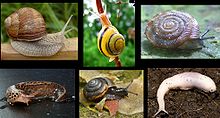Pulmonate
| Pulmonata Temporal range: Carboniferous–recent |
|
|---|---|
 |
|
| Various examples of Pulmonata | |
| Scientific classification | |
| Kingdom: | Animalia |
| Phylum: | Mollusca |
| Class: | Gastropoda |
| (unranked): |
clade Heterobranchia informal group Pulmonata |
| Taxonomic subdivisions | |
|
|
informal group Pulmonata
Cuvier, 1814
Pulmonata, or "pulmonates", is an informal group (previously an order, and before that a subclass) of snails and slugs characterized by the ability to breathe air, by virtue of having a pallial lung instead of a gill, or gills. The group includes many land and freshwater families, and several marine families.
The taxon Pulmonata as traditionally defined was found to be polyphyletic in a molecular study per Jörger et al., dating from 2010.
Pulmonata are known from the Carboniferous Period to the present.
Pulmonates have a single atrium and kidney, and a concentrated, symmetrical, nervous system. The mantle cavity is located on the right side of the body, and lacks gills, instead being converted into a vascularised lung. Most species have a shell, but no operculum, although the group does also include several shell-less slugs. Pulmonates are hermaphroditic, and some groups possess love darts.
The taxonomy of this group according to the taxonomy of the Gastropoda (Ponder & Lindberg, 1997) was as follows:
Order Pulmonata Cuvier in Blainville, 1814 - pulmonates
The taxonomy of this group according to the taxonomy of the Gastropoda (Bouchet & Rocroi, 2005) was as follows:
Contains the informal group Basommatophora and the clade Eupulmonata
...
Wikipedia
